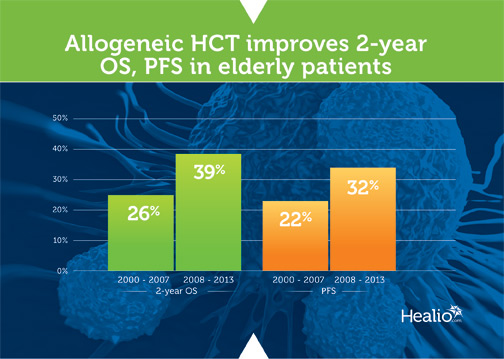Allogeneic hematopoietic cell transplantation increasing in elderly patients
Use of allogeneic cell transplantation increased in the past decade among patients aged 70 years and older with hematologic malignancies, according to findings published in Blood.
“Allogeneic hematopoietic cell transplantation offers the best potential for prolonged disease control for many hematologic malignancies,” Lori Muffly, MD, MS, of the division of blood and marrow transplantation at Stanford University, and colleagues wrote. “Historically, older adults were not considered candidates out of concern for increased toxicity and mortality, thus excluding the majority of hematologic malignancy patients who may have gained benefit.
Muffly and colleagues reviewed data from the Center for International Blood and Marrow Transplant Research, evaluating 1,106 patients aged 70 years and older who underwent their first allogeneic hematopoietic stem cell transplantation for hematologic malignancies between 2000 and 2013.
The proportion of allografts rose significantly, from 0.1% in 2000 to 3.85% (n = 298) in 2013. The most common diseases acute myeloid leukemia and myelodysplastic syndromes, and patients’ median age at time of transplantation was 72.
Both two-year OS and PFS improved significantly. OS rose from 26% (95% CI, 21-33) between 2000 and 2007 to 39% (95% CI, 35-42) between 2008 and 2013 (P < .001) PFS rose from 22% (95% CI, 16-28) between 2000 and 2007 to 32% (95% CI, 29-36) between 2008 and 2013 (P = .003).
Transplant-related mortality at 2 years did not change over time, ranging from 33% to 35% for the duration of the period studied (P = .54).
In the 2008 to 2013 period, a multivariable analysis of OS showed a higher comorbidity by hematopoietic cell transplant-comorbidity index 3 (HR = 1.27; P = .006), with myeloablative conditioning (HR = 1.61; P = .0002) and umbilical cord blood graft (HR = 1.97; P = .0002) as adverse factors.
“The utilization of allogeneic HCT in adults aged 70 years and older with hematologic malignancies has markedly increased over the past decade,” the researchers wrote. “Nearly 40% of adults in this age group are alive at two years following transplant, suggesting that this approach is feasible, offers promising disease control, and should be considered more frequently for patients in their eighth decade with transplant-eligible diseases.” – by Andy Polhamus
Disclosure : The researchers report no relevant financial disclosures.

